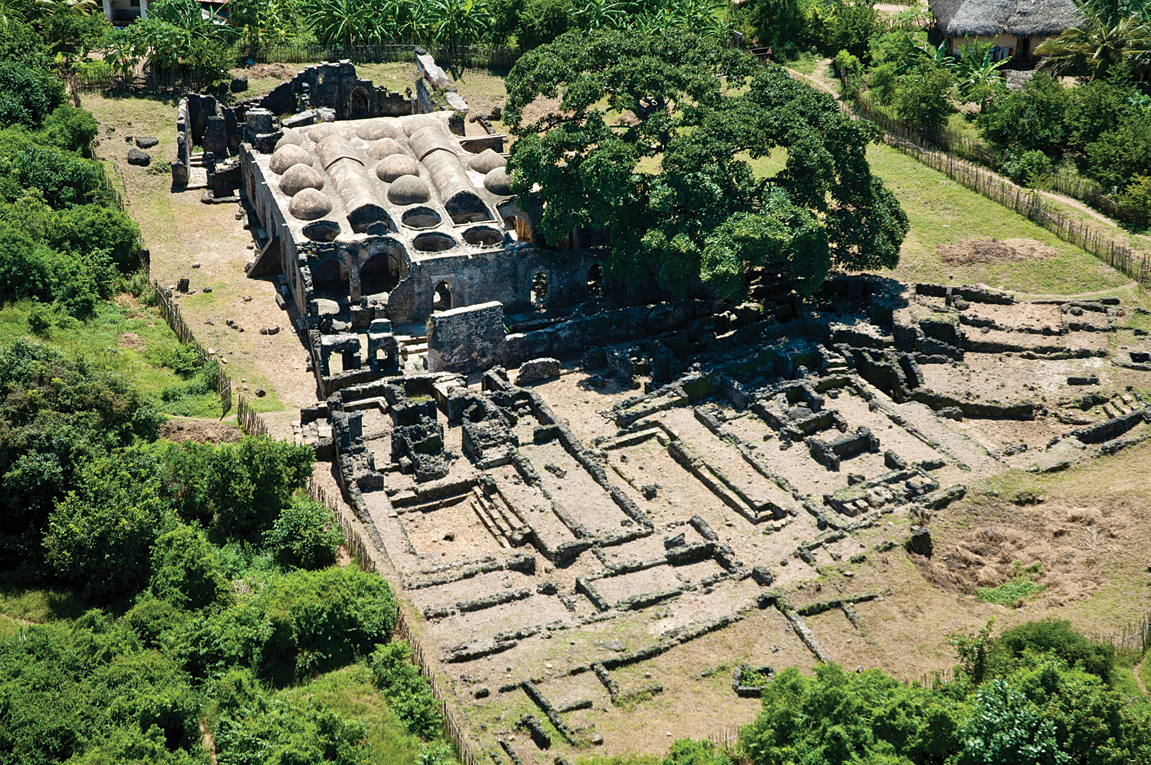A History of World Societies:
Printed Page 285
A History of World Societies Value
Edition: Printed Page 286
The East African City-States
Like Ethiopia, the East African city-
Greco-
In the early centuries of the Common Era many merchants and seamen from the Mediterranean settled in East African coastal towns. Succeeding centuries saw the arrival of more traders. The great emigration from Arabia after the death of Muhammad accelerated Muslim penetration of the area, which the Arabs called the Zanj, “land of the blacks,” a land inhabited by Bantu-
Migrants from the Arabian peninsula and the Malay Archipelago had a profound influence on the lives of the East African coastal people. Beginning in the late twelfth century fresh waves of Arabs and of Persians from Shiraz poured down the coast, first settling at Mogadishu, then pressing southward to Kilwa. Everywhere they landed, they introduced Islamic culture to the indigenous population. Similarly, from the first to the fifteenth centuries Indonesians crossed the Indian Ocean and settled on the African coast and on the large island of Madagascar, or Malagasy, an Indonesian name. All these immigrants intermarried with Africans, and the resulting society combined Asian, African, and especially Islamic traits. The East African coastal culture was called Swahili, after a Bantu language whose vocabulary and poetic forms exhibit a strong Arabic influence. The thirteenth-
By the late thirteenth century Kilwa had become the most powerful coastal city, exercising political hegemony as far north as Pemba and as far south as Sofala (see Map 10.2). In the fourteenth and fifteenth centuries the coastal cities were great commercial empires, comparable to the Italian city-

Much current knowledge about life in the East African trading societies rests on the account of Ibn Battuta. When he arrived at Kilwa, he found “a large city on the seacoast, most of whose inhabitants are Zinj, jet-
From among the rich mercantile families that controlled the coastal cities arose rulers who governed both the main city and surrounding territory. Such was the case with the island city of Kilwa and the nearby mainland. These rulers took various titles, including king, sultan, and sheik.

Approaching the East African coastal cities in the late fifteenth century, Portuguese traders were astounded at their enormous wealth and prosperity. This wealth rested on the ruler’s monopolistic control of all trade in the area. Some coastal cities manufactured goods for export: Mogadishu produced cloth for the Egyptian market, Mombasa and Malindi processed iron tools, and Sofala made cottons for the interior trade. The bulk of the cities’ exports, however, consisted of animal products — leopard skins, tortoise shell, ambergris, ivory — and gold, which originated in the Mutapa region south of the Zambezi River. As in tenth-
African goods satisfied the global aristocratic demand for luxury goods. In Arabia leopard skins were made into saddles, shells were made into combs, and ambergris was used in the manufacture of perfumes. Because African elephants’ tusks were larger and more durable than those of Indian elephants, African ivory was in great demand in India for sword and dagger handles, carved decorative objects, and the ceremonial bangles used in Hindu marriage rituals. Wealthy Chinese also valued African ivory for use in sedan chair construction. (See “Viewpoints 10.2: Visiting Africa.”)
In exchange for these natural products, the Swahili cities brought in, among many other items, incense, glassware, glass beads, and carpets from Arabia; textiles, spices, rice, and cotton from India; and grains, fine porcelain, silk, and jade from China. Swahili kings imposed enormous duties on imports, perhaps more than 80 percent of the value of the goods themselves. Even so, traders who came to Africa made fabulous profits.
Slaves were another export from the East African coast. Reports of East African slave trading began with the publication of the Periplus. The trade accelerated with the establishment of Muslim settlements in the eighth century and continued up through the arrival of the Portuguese in the late fifteenth century, which provided a market for African slaves in the New World (discussed in Chapter 15). In fact, the global slave market fueled the East African coastal slave trade until at least the beginning of the twentieth century.
As in West Africa, traders obtained slaves primarily through raids and kidnapping. As early as the tenth century Arabs from Oman enticed hungry children with dates. When the children accepted the sweet fruits, they were abducted and enslaved.
The Arabs called the northern Somalia coast Ras Assir (Cape of Slaves). From there, Arab traders transported slaves northward up the Red Sea to the markets of Arabia and Persia. Muslim dealers also shipped blacks from the Zanzibar region across the Indian Ocean to markets in India. Rulers of the Deccan Plateau in central India used large numbers of black slave soldiers in their military campaigns. Slaves also worked on the docks and dhows (typical Arab lateen-
As early as the tenth century sources mention persons with “lacquer-
By the thirteenth century Africans living in many parts of South and East Asia had made significant economic and cultural contributions to their societies. It appears, however, that in Indian, Chinese, and East African markets, slaves were never as valuable a commodity as ivory. Thus the volume of the Eastern slave trade did not approach that of the trans-